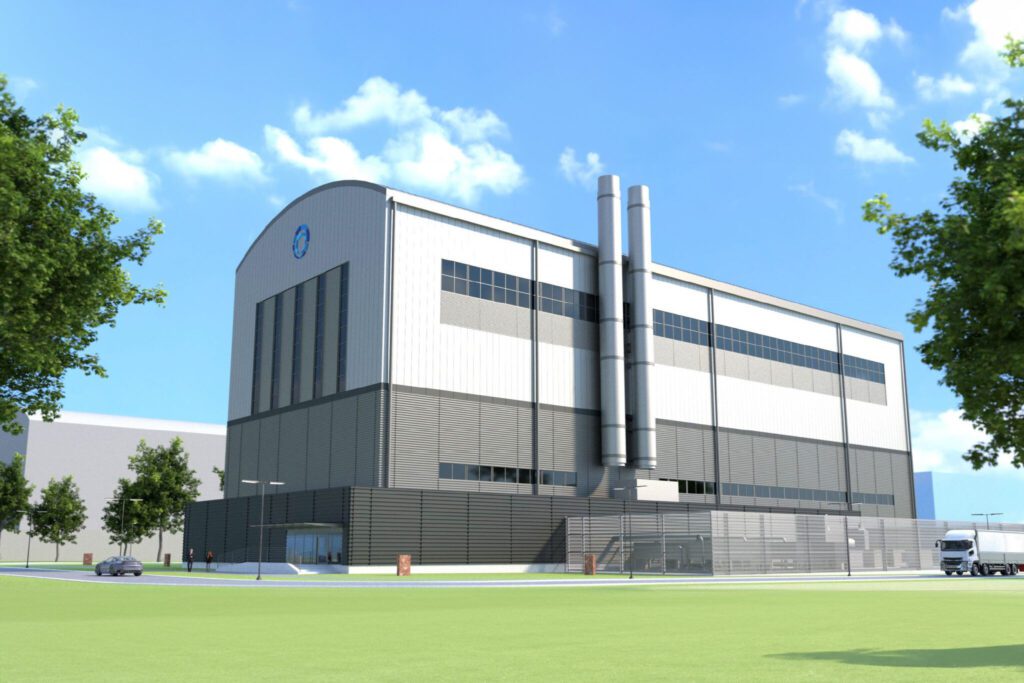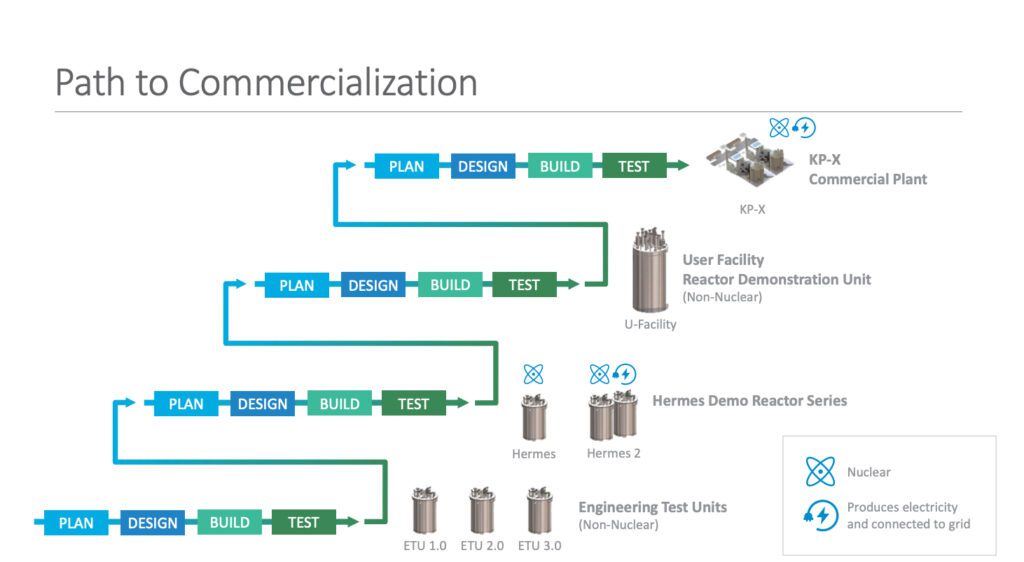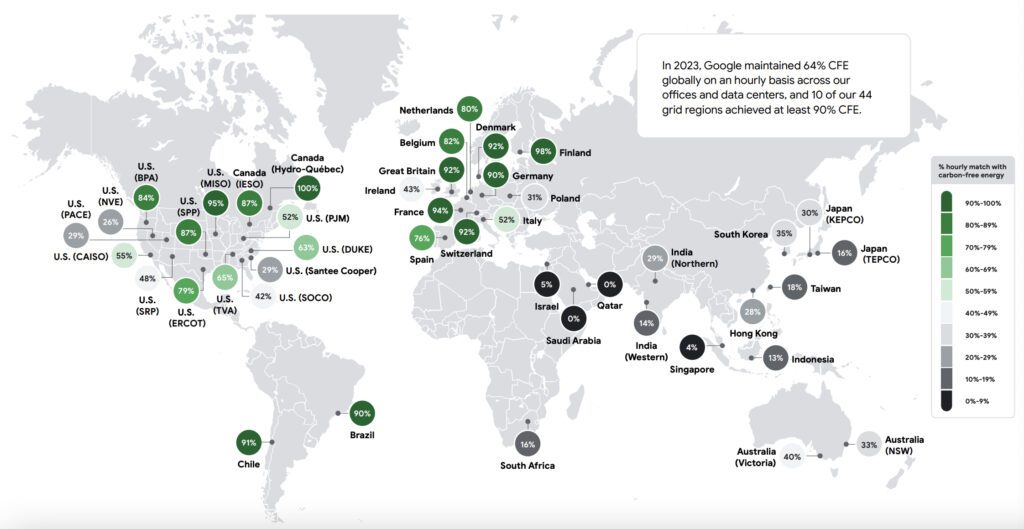Google Bets Big on Nuclear: Inks Deal with Kairos Power for 500-MW SMR Fleet to Power Data Centers
In a deal that marks the first corporate agreement to deploy multiple small modular reactors (SMRs) in the U.S., Kairos Power and Google have signed a Master Plant Development Agreement to facilitate the development of a 500-MW fleet of molten salt nuclear reactors by 2035 to power Google’s data centers. The first reactor is expected to be operational by 2030.
The agreement positions Alameda, California–based Kairos Power, developer of the fluoride salt-cooled high-temperature reactor (KP-FHR), to develop, build, and operate a series of advanced reactor power plants. Kairos will sell the plants’ energy, ancillary services, and environmental attributes to Google under power purchase agreements (PPAs).
According to Google Senior Director of Energy and Climate Michael Terrell, the initial phase of work will focus on bringing Kairos’ first reactor online “quickly and safely” by 2030, followed by additional reactor deployments through 2035. Plants will be sited in “relevant service territories to supply clean electricity to Google data centers,” the companies said in a joint statement on Oct. 14.
Kairos declined to reveal specifics about how many reactors it plans to deploy under the agreement. However, its targeted commercial power plant offerings currently include the KP-X “commercial demo plant,” a 50-MWe single-unit plant, and the KP-FHR “commercial plant,” which is a dual-unit 150-MW installation.
The multi-plant agreement represents a significant boost for Kairos, which has emerged as a solid frontrunner in the world’s burgeoning advanced nuclear market. “Having an agreement for multiple deployments is important to accelerate the commercialization of advanced nuclear energy by demonstrating the technical and market viability of a solution critical to decarbonizing power grids while delivering much-needed energy generation and capacity,” noted Jeff Olson, vice president of Kairos Power Business Development & Finance.
“This early commitment from Google provides a strong customer demand signal, which reinforces Kairos Power’s continued investment in our iterative development approach and commercial production scale-up,” Olson underscored.
For Google, the agreement signals definitive confidence in nuclear’s ability to meet the growing energy demands of its data centers. Google, which has already signed 115 agreements for 14 GW of renewable capacity, is committed to catalyzing new nuclear development to bolster its net-zero and 24/7 carbon-free energy goals, said Terrell.

A Critical Customer Demand Signal for Kairos
Kairos, founded in 2016, has been developing its molten salt technology via a “rapid iterative” development approach, which includes hardware demonstrations and in-house manufacturing “to achieve disruptive cost reduction and provide true cost certainty for commercialization.”
The company recently kicked off the construction of Hermes, a 35-MWth iterative non-power demonstration molten salt nuclear reactor, in Oak Ridge, Tennessee. When it comes online as anticipated in 2027, Hermes will become Kairos’ first nuclear build. That achievement follows substantial progress on a series of Engineering Test Units (ETUs), which are non-nuclear integrated tests.
In tandem, the company has made headway on the production of high-purity fluoride salt coolant for its iterative reactor series. Earlier this month, it broke ground on its Salt Production Facility at Kairos Power’s Manufacturing Development Campus in Albuquerque, a crucial facility that will utilize a “proprietary chemical manufacturing process” to produce Flibe, a chemically stable molten fluoride salt comprising a mixture of lithium fluoride and beryllium fluoride salts (2LiF:BeF2) enriched in lithium-7. The fluoride salt, which will be used as a primary heat transfer fluid in Kairos’ KP-FHR technology, allows Hermes and future iterations to “operate at low pressure and plays an important role in radiological containment, which contributes to KP-FHR’s robust inherent safety and simplifies its design,” Kairos noted on Oct. 2.
Kairos is also developing fuel development lab facilities at its Albuquerque campus to focus on prototyping and innovation in design-build-test cycles to advance Kairos’s fuel production capabilities prior to commercial deployment, city documents suggest. The KP-FHR, notably, is designed to operate at high temperatures and near‐atmospheric pressure, using tri-structural ISOtropic (TRISO) particle fuel in pebble form with a carbonaceous‐matrix coated particle design.
Finally, as part of its iterative approach, Kairos has marked numerous regulatory milestones. In December 2023, the Nuclear Regulatory Commission (NRC) granted Kairos a construction permit for its 35-MWth Hermes “non-power” demonstration. The NRC’s approval for Hermes, notably, marked the federal regulator’s first green light for the construction of a non-water-cooled reactor in more than 50 years.
The new partnership with Google adds another integral layer of certainty to Kairos’ development process. The partnership agreement will incorporate a milestone-based accountability process, similar to one Kairos pioneered as part of a $303 million federal award it received under the Department of Energy’s (DOE’s) Advanced Reactor Demonstration Program (ARDP) risk reduction pathway.
“Our partnership with Google will enable Kairos Power to quickly advance down the learning curve as we drive toward cost and schedule certainty for our commercial product,” said Mike Laufer, Kairos Power CEO and co-founder. “By coming alongside in the development phase, Google is more than just a customer. They are a partner who deeply understands our innovative approach and the potential it can deliver.”

Google’s Key Objective: Accelerate the Clean Energy Transition
As Terrell explained in a blog post on Monday, Google’s imperative stems from a commitment to sustainability. In 2020, the company set a goal to run on 24/7 carbon-free energy (CFE)—“every hour of every day on every grid where we operate”—by 2030. The company is pursuing a three-pronged approach to achieving Scope 2 emission reductions: purchasing CFE, accelerating new and improved technologies, and transforming the energy system through policy, partnerships, and advocacy.
So far, the tech giant has pursued innovative pathways to achieve its CFE ambitions. As Terrell noted, it was pivotal in pioneering corporate and industrial PPAs for renewables, starting in 2010 with a landmark 20-year agreement for wind energy in Iowa. The model has allowed Google to directly purchase renewable energy at the wholesale level, helping to secure large-scale clean energy for its data centers. By the end of 2023, it had signed more than 115 agreements to purchase 14 GW of clean energy at an estimated expenditure of $16 billion through 2040. But the model has also catalyzed a massive development of new wind and solar projects. “This approach has been incredibly successful: since 2008, corporate clean energy buyers have unlocked nearly 200 GW of new solar and wind capacity around the world,” Google says.
However, Google has since recognized that the approach is limited. “PPAs are often isolated from broader grid planning and utility investment processes, and the variability of the weather can mean inconsistent solar and wind availability,” the company explained. “Therefore, fully decarbonizing electricity systems will require other technologies that can deliver clean power whenever it is needed (also known as ‘clean firm capacity’).”
In June, Google partnered with NV Energy to launch a first-of-its-kind Clean Transition Tariff (CTT), a mechanism that will allow Google and other energy users to meet growing electricity demand with 24/7 carbon-free energy from “firmer” carbon-free capacity, such as enhanced geothermal, long-duration energy storage, and advanced nuclear power. NV Energy is now notably working with geothermal developer Fervo Energy to deliver 115 MW of new enhanced geothermal power to the CTT partnership and its full capacity to Google. The agreement builds on Google’s backing of Fervo Energy’s 3.5-MW Project Red. Google and Fervo signed the world’s first corporate agreement to develop the next-generation geothermal power project in Nevada, and the project has since proved that Fervo’s technology can deliver enhanced geothermal power at a commercial scale.
Google’s agreement with Kairos seeks similar gains with advanced nuclear. “Overall, this deal will enable up to 500 MW of new 24/7 carbon-free power to U.S. electricity grids and help more communities benefit from clean and affordable nuclear power,” Terrell wrote on Monday.
“By procuring electricity from multiple reactors—what experts call an ‘orderbook’ of reactors—we will help accelerate the repeated reactor deployments that are needed to lower costs and bring Kairos Power’s technology to market more quickly,” he said. “This is an important part of our approach to scale the benefits of advanced technologies to more people and communities and builds on our previous efforts.”
Google’s Expanding Quest for Reliable Carbon-Free Energy
The nuclear agreement is significant for two key reasons, Terrell said. First, the “grid needs new electricity sources to support [artificial intelligence (AI)] technologies that are powering major scientific advances, improving services for businesses and customers, and driving national competitiveness and economic growth,” he said. “This agreement helps accelerate a new technology to meet energy needs cleanly and reliably, and unlock the full potential of AI for everyone.”
Second, nuclear energy offers a round-the-clock, carbon-free power source that can meet electricity demands at all times. By working closely with local communities, the deployment of advanced nuclear reactors could help drive the decarbonization of power grids worldwide, he added. In addition to its environmental benefits, Google sees nuclear as an economic driver. The DOE “estimates reaching 200 GW of advanced nuclear capacity in the U.S. by 2050 will require an additional 375,000 workers,” he said.
Compared to large nuclear projects, advanced nuclear reactors offer “a new pathway to accelerate nuclear deployment thanks to their simplified design and robust, inherent safety,” he added. “The smaller size and modular design can reduce construction timelines, allow deployment in more places, and make the final project delivery more predictable.”
Momentum for a nuclear revival driven by data center power demand is already beginning to crop up. As POWER reported in September, Microsoft and Constellation Energy committed $1.6 billion to restart the Unit 1 reactor of the shuttered Three Mile Island in Pennsylvania by 2028. The facility, known as the Crane Clean Energy Center, could supply Microsoft’s AI-driven data centers for at least 20 years. Amazon Web Services, similarly, last year bought a 960-MW data center campus powered by the 2,500-MW Susquehanna nuclear plant.
McKinsey: Nuclear Power Seen as Medium-Term Solution for Data Center Demand
According to Google’s June–released 2024 Environmental Report, the tech giant’s data centers around the world consumed 24 TWh in 2023, which represents 7% to 10% of global data center consumption and about 0.1% of global power demand. However, last year’s figures represented a 17% (3.5 TWh) jump in the company’s data center power consumption—even though Google has said that it strives to build the “world’s most energy-efficient computing infrastructure.”
The company also says that while it has maintained a 100% global renewable energy match for seven years now, in 2023, its data center power needs were met by a global average of about 64% CFE.
“Achieving 24/7 CFE is a far more complex and technically challenging pursuit than annually matching our energy use with renewable energy purchases, but we see this effort as crucial to a bigger picture: scaling new, global solutions for clean energy,” it says. In 2023, for example, its efforts to increase CFE procurement faced a number of headwinds, including “interconnection delays (such as in the PJM grid region), higher development costs and project demand, supply chain issues, U.S. regulatory tariffs for solar modules, natural variability in generation, and continued load growth in certain regions with CFE market constraints (such as in the U.S. and the Asia-Pacific region).”

Overall, Google notes that in 2022, total global data center power consumption hovered at 340 TWh, translating to about 1.3% of global electricity demand. The International Energy Agency (IEA) estimates data centers around the world consumed much more in 2022—460 TWh—and it suggests their total consumption could surge sharply to more than 1,000 TWh in 2026—roughly equivalent to Japan’s total consumption. Other research groups suggest even more exponential growth. EPRI estimates that data centers could grow to consume up to 9% of U.S. power generation annually by 2030, up from 4% of total load in 2023.
Consulting group McKinsey adds more weight to these projections in a September 2024 analysis, estimating power demand from data centers in the U.S. could increase by 400 TWh by 2030, at a compound annual growth rate (CAGR) of 23%. McKinsey further notes that “Data center load may make up between 30 and 40% of all net new demand added until 2030,” alongside growth arising from domestic manufacturing, electric vehicles, and electrolyzers.
“With hundreds of terawatt-hours of additional energy demand expected in the coming years, there will be a commensurate demand for clean power for hyperscalers and other large players that have put forth leading climate commitments,” the group says. In the short term, the desire for additional renewable projects is expected to sustain the high PPA rates, it predicts. “While many technologies—offshore wind, fission, fusion, geothermal, gas carbon capture and storage, and clean fuels, for example—may be able to supply this energy in the medium to long term, the bulk of new clean generation is expected to come from solar and onshore wind,” it says.
The opportunity for nuclear power, however, is becoming more compelling. “The supply profile of nuclear plants is consistent and reliable, which would work well with the average data center demand,” it said. In addition, “The scale of a nuclear power plant is on par with that of a data center campus based on cost per megawatt of IT load.” Another advantage, according to McKinsey, is that “Hyperscalers have the balance sheets and timelines that could afford them a higher risk appetite for investing in nuclear if these investments could create a differentiated advantage.”
Still, McKinsey outlines several concerns. “Nuclear power is a medium-term solution. The timeline to scale nuclear so it can achieve rapid, repeated deployment is nearly a decade, while constraints on data center power are appearing today,” it notes. And, for right now, the “early economics of nuclear are challenging compared with other energy options, and implementing various technologies to try to reduce its costs may or may not work.”
Ultimately, for nuclear to play a role in the “generative AI revolution, investment in the sector to scale would need to be significant, but the payoff could be worthwhile, especially as load continues to grow,” well into the mid-term, it says. “Demand could increase by 75% by 2040, reaching 6,908 TWh,” it notes.
—Sonal Patel is a POWER senior editor (@sonalcpatel, @POWERmagazine).